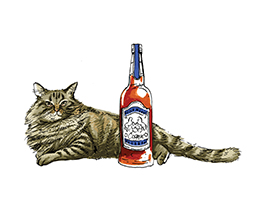For several years now, the holiday batch of wine books has become increasingly divided between the “elitists” and the “populists.” The former are the critics, who toss out bushel baskets of flavors (tar, black fruit, chocolate, licorice and old leather) and anthropomorphize wines. The others are the proud wine amateurs (aka “wine lovers”), whose diatribes against the “Parkerization” of wines—the reliance on numerical scores for wines and the trend toward bigger, fruitier, mine-is-bigger wines preferred by Wine Advocate founder Robert Parker—can be as stringent as their own self-promotion.
This polemical tug of war can easily bewilder those looking to give a wine book as a gift (which side are your friends on?), but there are some new volumes that can safely be delivered to any wine lover. Along with a bottle, of course.
Many guides to appreciating wine veer from cutesy to condescending, but food mag columnist Dara Moskowitz Grumdahl’s Drink This: Wine Made Simple, finds a happy medium, keeping the catchphrases to a minimum while gently prodding wine newbies through the nine varietals that dominate American shelves and restaurant lists. Each chapter winds through the pros and cons (what’s to love, what’s to hate) of each varietal, a brief history, major taste markers and a comparison of bottom-shelf and top-shelf styles. Each chapter ends with a quick cheat sheet and suggestions for gifts, from inexpensive to “knock-their-socks-off” labels.
Entertaining sidebars (what really causes the famous “cat pee” smell in Sauvignon Blanc?) and interviews with respected winemakers, along with sensibly straightforward tips on hosting low-key wine tastings (example: put a tablespoon of peppercorns or some shaved chocolate in a wine glass and sniff before tasting a Zinfandel or Pinot Noir), make this a solid primer. And, unlike most guides, Drink This occasionally includes pronunciations of wines (rhyming Shiraz with pizzazz, for instance).
Can’t-miss bargains
It’s a serious sign of the economic times that Robert Parker and his Wine Advocate team have produced Parker’s Wine Bargains: The World’s Best Wine Values Under $25. It’s a paperback, described as Zagat guide-sized, though in fact it’s a little hefty for the pocket. It reveals a little about the magazine’s biases—France is divided into eight regions, while all the regions of Italy are lumped together; and only California, Oregon and Washington wines are covered in the United States. Nevertheless, this might be a great book for someone looking to acquire collectable wines without breaking the bank. Wines are marked by price ($ for under $10, etc.) and relative dryness.
The guide’s other concession to more modern wine culture is its emphasis on the fact that less expensive wines need much less aging than the big names, so that most whites and rosés listed should be consumed within a year or so and the reds within three to five years. In other words, you can stop fretting about laying it down and start drinking it up.
A browser’s delight
The third sort of wine book—after the how-tos and the must-haves—might be called the bedside wine book: collections of anecdotes or literary references or ruminations on wine, generally short enough to be consumed a few at a time (presumably over a nightcap). Is This Bottle Corked? The Secret Life of Wine by Kathleen Burk and Michael Bywater is one of those, a combination of fact (what is corkage?) and fiction. What color “wine-dark sea” did Homer really see? Could the Duke of Clarence really have been drowned in a butt of Malmsey? And what is Malmsey, anyway? The Bible, Beaujolais Nouveau, Omar Khayyam, Napoleon, Jane Austen, Pliny and (of course) Robert Parker; phylloxera, absinthe, unami, foot-stomping, silver wine goblets and the dreaded “winespeak”—these and scores of other characters and controversies cohabitate comfortably in this chatty little collection.
A classic returns
Grumdahl’s guide notwithstanding, it would be ungenerous not to toast one notable perennial on these lists: Kevin Zraly, onetime wine director at New York’s Windows on the World, who turned his master classes for the staff into a course that eventually graduated 19,000 people. (When the World Trade Center was destroyed on 9/11, it had nearly 100,000 bottles in the cellar; Zraly himself had taken the day off to celebrate his son’s birthday.) Zraly has been updating his eminently sensible and accessible Windows on the World Complete Wine Course on a pretty regular basis, but he’s just released the 25th anniversary edition. For someone who’s already a little more at ease ordering wine and wanting to expand his palate, or for a sentimental New Yorker, this might be the perfect choice.
Eve Zibart is a former restaurant critic for the Washington Post.



















